Text
Fade to Black; Metallica
youtube
My Most Favourite Songs of All Time Part 1
Not ordered, only as I encounter them again.
How Deep is Your Love; Bee Gees
youtube
Nothing Else Matters; Metallica
youtube
Your Song; Elton John
youtube
Everything’s Alright; Jesus Christ Superstar
youtube
Working Day and Night; Michael Jackson
youtube
1 note
·
View note
Text
The Many Faces in the Cellar
As we digitise and artifisicse, we dehumanise and desensitise ourselves to the world of life in which we resonate; what it really means, what is contains, what it can really be, what we are in the ether and the resonance of those around us now, before and in the future. We blind ourselves to the universe of existence, in which we exist and can only see through faith, belief and soul. All fades when you move away from them in.
I exist in that direction and move toward.
On a recent visit to Germany, I was in the ancient town Gorlitz and I went into a house built in 1721. A house that should remain anonymous to protect that which reside there and not to sensationalise truth that many can not or will not understand
With 320 years of history, in a town dating back to the Roman via Regia, in a street frequented by Templars and a place with a secret ancient hidden church and secret legacy, this house has stories or life.
The house is very large and spacious. As you enter you first see a coat of arms that symbolises a secret society or cult that may focus on the occult (I'm currently researching this).
We started our tour on the ground floor and then went down to the cellar. This route was preferred because the cellar is the most unusual I've ever seen.
You enter down a flight of stone steps into a rather regular 18th century German stone floor and walled cellar, with rooms leading off a central corridor. Then through an arch at the end the wonder begins down a flight of stone steps into a support free, square chamber on 10m squared or more and a 5m high ceiling.
A single door in and a single door out, down to another similar sized chamber, although in here the floor is earthen and soft. It's challenging to image why these large cellar chambers are built in this way or for what they were used over the 320 years, several wars, the atrocities and a secret society local legacy.
As we left the lower cellar, I was last out, pondering the purpose. As we left the upper chamber I felt a sudden urge that I should be taking images of such an unusual and intriguing place. The urge was unusual because we were considering a purchase of the property and I can remember the basic required for this and wondered when we would ever look back at the image of a basement. However, I stopped, turned and took an image of the entry point to the upper chamber.
We continued the tour to every floor of this incredible and interesting property. The viewing was a success to ignite interest.
As many of you will know I enjoy posting images to Instagram and Twitter and when I'm on holiday i have time to post more, working through my camera line image by image when I have a spare moment.
A few days later and I opened the image from the basement and found one of the greatest images I've ever taken. Genuine, unfiltered, random and real; an unparaleled image of paranormal activity. The like of which I have never seen in comparison.
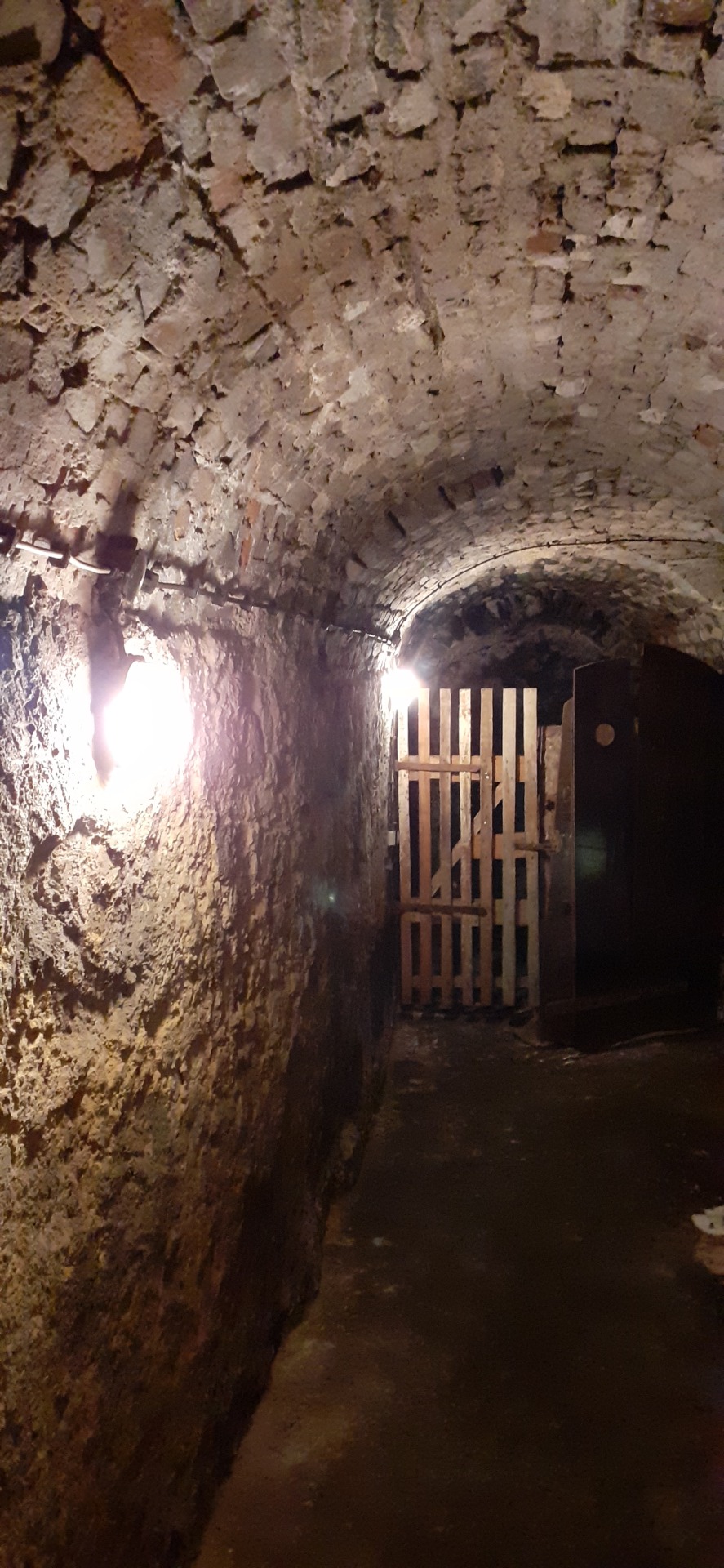
My experience immediately picked out the interest of three orbs and I zoomed in for a closer look; first at the orb in the center of the image:

I see a face with wide open mouth, hollow eyes and a button nose, with the centre of the orb light in the centre of the skull.
I zoomed in on the second orb to the right and before I centred the image I saw:

A hand, back facing the camera, holding the post.
I centred to the orb and knew then that I have captured a remarkable image:

A clear face, with a deliberate look of intent from a detailed eye. The more I see this image the more I see the powerful manifestation it is:

The detail and intensity of the right side eye and the additional face within the surround of the left eye.
Whilst studying the image I realised that the face an hand are likely and well positioned to be one manifestation:

This realisation in isolation is an indication of a spirit of incredible power, a correlation of visual manifest from one being, clearly observing my presence. Every time I look at this image I feel the presence and my skin crawls, I'm drawn to eye contact and thought attachment.
Every time I view it I move on quicker, as it feels as though it reaches through to me. I see sometimes an inquisitive look, sometimes a deliberate stare and on my last view just now I see the mouth opened wide in a scream with sharp teeth in the upper and lower, squared jaw.
From this I had to study the image in detail and I found image on image to support the immense spiritual activity that exists in that basement.
A close up on the second, smaller orb reveals another face, up turned and mouth agape. The sharpest of the light orb shining from the centre of the head, above wide hollow eye sockets.

Above the foreground wall lamp, a large cranial head with black eyes narrowing into a small grimacing mouth. The centre of the right side eye holds a spark of light.

A screaming face in the edge of where the floor meets the wall:

A concentrated look from the wall with large hollow eyes and a downturned mouth:

A face looking up from the floor, with fleshy features and a small, pursed mouth:

To equal the power of the gate post face I noted the face of a spirit behind the gate. Strands of hair cascade over the left side eye above clear lips and a flash of teeth:

It was later that I realised that light shapes at the base of the gate look like lower legs:

This are proportionately placed to the face above and a midway light like hand; a whole standing spirit:

Wide, lizard like, Demon eyes in the floor from an upside down face:

A face in the gate, with horns, small round ear and an upturned nose:

Above the figure behind the gate is what may be a white mist manifestation:

This may be from the main figure or the sheer power of multiple manifestations of sprit face, at least three faces appear within the mist. Here's three forming, particularly in the lower right corner with a human, demon blending.

There is a wide variety of states of manifestation, some are more subtle, although may also be blends of different spirits, making each viewing of the piece of the image different and enabling the viewing of multiple faces.

This view was clearer of a the side of a skull like face.

This face has a broad smile.

Some are forming from ethereal mists.

This myriad of manifestation across the image are juxtaposed and perhaps all connected to the energy forming the clear demon face, arm and hand with other stronger images like the spirit rising itself from where the floor meets the wall.

This discovery, the incredible spiritual activity and that face haunt me with intrigue to understand and learn more.
0 notes
Text

The National Health Service in the UK, probably the greatest free health service in the world is broken at such a fundamental level that it must undertake significant and serious reform. We have the medical expertise, pharmaceutical expertise, care, knowledge, understanding and finance. The issue is only with how the service is managed, it can only be the management and leadership that is not operating effectively because we have world class leading everything else. This implies that it is how we use the resources which is at issue. Could the issue be the way the service has been organised. Organisation is a critical integral part of management. The NHS is organised by segregation into a myriad of pieces, trusts. Each Trust has a board, executives, senior, middle and operational management, administrative team. There are further layers of services in property, maintenance, cleaning, laundry, security, procurement, resources and other non-clinical patient services. Each layer is cost, each segment is cost, multiple layers and segments are repetition of cost multiplied across the nation. Could a return to origin bring the simplification required. Like any service this service is a business. In business this would either be a franchise or a single business. A single business would enable the consolidation of non-clinical services, resources, procurement, security, laundry, cleaning, maintenance and property. This consolidation may include some outsourcing to enable the NHS to focus of its clinical, medical purpose. Imagine the cost you could avoid and repurpose into the medical treatment or patients. This requires consolidated management, consolidated leadership and behaviour as a cohesive service, a collaborative brand.
8 notes
·
View notes
Text
Alien Covenant: Ridley Scott takes the Alien collection back to a genius level to equal his original Alien (also in this collection) and for the first time since James Cameron created Aliens.
youtube
My Most Favorite Movies of All Time Part 1
Not ordered, only as I encounter them again:
Predator: Arnie at his best; simple story, jungle, big action, survival, aliens.
youtube
Devil: M Night Shyamalan; simple story, confined space, posession, double twist, excellent opening music & footage.
youtube
Alien: Ridley Scott, HR Giger, Sigourney Weaver, Ripley, Ian Holm, John Hurt; iconic first introduction to one of the most fearful and amazing extraterrestrials ever created. First presented to an audience familiar with the fantasy of a safe Star Wars and Star Trek. This movie set a new benchmark which still stands in a class of its own.
youtube
The Thing, original 1982: John Carpenter, Stan Winston creature, Ennio Morricone score, remote, isolation, Antartica, desolate, cold, trust, ancient Aliens.
youtube
1 note
·
View note
Text
Wearables Futurology
Does the impact of COVID19 provide the greatest opportunity for wearable technology to shape the future, as humans take up their opportunity to cover their hands and faces with products that make them feel protected, safe and empowered to connectivity with the technology to which they have become accustomed.
Masks that speak for us, or analyse the health of our breath. Built in microphones, fluids, voice enhancers.
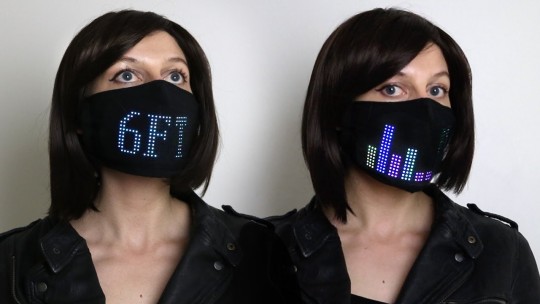
The breath analysis could extend to an improved understanding of our nutritional requirements, perhaps even interfacing with dietary advice or the management of our diets, ordering food, beverage, supplements, ingredients and meals on our behalf to improve the results of the analysis.

Gloves to protect your hands from surface contact will allow mobile payment, access control, digital device and technology interfacing.

They will also analyse the surfaces we touch and provide warnings, self cleansing or feedback to support teams for local cleaning.
They will interface with AI to enhance the learning and delivery capabilities of our hands, enabling sign language, musical instrumental control or device interactivity with equipment to operate items effectively and safely with no prior knowledge.
They will feature robotic exoskeletal enhancements for additional power.

They will become fashion statements and accessories.

Goggles, glasses and face masks that protect our eyes and face whilst enabling visual enhancers, video connections, entertainment viewing and mobile device interconnectivity or replacement.

This becomes even more valuable amidst the current medical PPE crisis of many countries, wearables could provide for both the protective, communicative and medical informative and diagnostic functions.

Both for personal and professional applications the wearables would enable augmented reality.

There would be more personalised opportunity to interface with holographic content and projection.

The band of an eyewear or a face mask could also provide personal health monitoring, memory enhancement or mind control over other devices or features of personal technology, including how it interacts with other systems and devices.

Full face masks will include all of the features of facial wearable technology and even provide for projecting your digital social persona or creating digitally enhanced fashion statements.
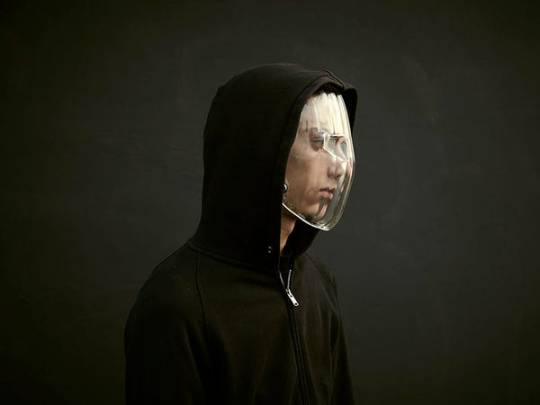
Full body wearbles could extend this shield of safety and interactivity into a fully immersive bubble of wearble tech.
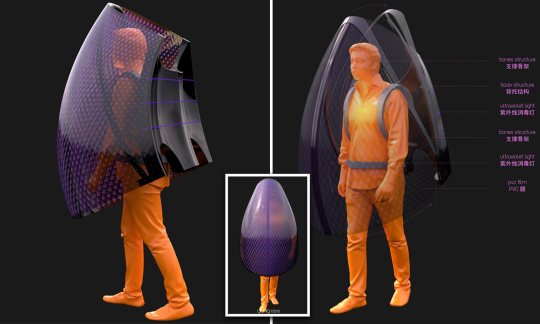
We are on the verge of an incredible opportunity for wearables to launch into the future shaping history books of technological advancement. What will you be wearing?
#wearable#wearable electronics#wearabletherapy#wearable technology#wearable app development#face mask#face shield#face shields#goggles#glasses#gloves#cocoon#future technology#tech#enhancement#digital enhancement#immersive#immersiveexperience
3 notes
·
View notes
Text

Powerful images from https://www.facebook.com/Villapollo #chile
Create your power.
0 notes
Text
The Mysterious Unterkirche of Peterskirche, Gorlitz
In the heart of the mystical town of Gorlitz on the German, Polish border, the majestic Peterskirche stands, almost hidden amongst the narrow streets and tall houses and yet there it rises.
This ancient church hides an ancient secret.
On my visit to the church I noticed a small paper sign pointing out a crypt, which is usually an interesting point to explore and seek out spiritual secrets and inspirations, so I enquired.
The attendant behind the church entrance counter was not particularly impressed that I had asked but explained that it was not a crypt but an unterkirche or under church, an older church on top of which the larger, obvious, Peterskirche was built.
This news was exceptionally interesting, more so than a crypt as perhaps it indicated that Perterskirche was purposefully built on top of the older church because of the significance of the older church and often this would have happened in veneration of the purpose of the older church or the energy associated with it or perhaps to hide the older church because of what it represented.
The attendant informed me that the unterkirche was open later and I should return at 2pm.
I returned at 2pm and a different attendant was at the counter, with an unusual bandage over his ear lobe. I enquired with him regarding the unterkirche and he advised me that is was only open until 1.30pm and now it was in use by a regular Polish community service but if I returned at 10am in the morning I could join a tour of the church. The time contradictions were intriguing and both attendants seemed reluctant to enable the access. It was also odd that the first attendant had not known about the regular service.
I returned at 10am the next day and found that the entrance to the unterkirche is a large wooden door in the south east corner. It was down some steps, so disguised in importance as it appeared to be just a side entrance into Petershirche.
The first attendant I met was inside and I joined an organised tour.
I found immediately one of the most interesting churches I have ever experienced and for those who follow me in social realise that churches are usually my first and most frequently visited location on any travels.
Although initially it was just interesting it was the explanation of what hung below which opened the inspiration.

This preserved patch of stone work has what appears to be a scorch mark on the in the shape of a crown of thrones.
The guide explained that a gold crown of thorns had once hung on the wall in this exact location.
What was particularly unusual was that this mark appeared to be directly on the stonework and was too exact to be dust or dirt and seemed to be burnt onto the stone.
The guide explained that the precise location was to reflect the sunlight, which on a particular day would rise into the adjacent window.
This placement is significant in the recognition of both the sun, light and the hour of the day on which this reflection would occur. Identifying this date would indicate the focus of the veneration. It is also highly likely on the basis of this story that the sun inspired window was placed in that particular location as the church was being built.

The sun appears to rise in this North Eastern aspect in April, May and June, achieving a particularly Northern rise from late May to late June. Within this date range falls the Christian celebrations of the Day of Ascension and Pentacost before the solstice, followed by Corpus Christi, All Saints, Sacred Heart of Jesus and the Feast Day of St Peter and St Paul.
The use of the sunlight indicates that the placement relates to the solstice and narrows the focus to either the day of Sacred Heart of Jesus or the Feast Day of St Peter, after whom the church is named. However the name is given to the larger, newer church above the unterkirche and therefore this may be a distraction and therefore indicates more that the use of the light respects the day of Sacred Heart of Jesus, which has a much more interesting meaning in the esoteric.
We can not discount the use of the crown of thorns, which could change the focus to the Day of Ascension.
The only way to know now with confidence would be to watch for day of the moment of reflection into the church through the window and this will indicate the exact day to which this church, or perhaps part of its purpose is dedicated.

The point to where the light reflects is the west wall of the church and said to once have three altars, one for three different religious groups who shared use of the church. This introduces a new perception on the purpose of this church, the unusual placement of altars on the west side (although not in place currently). The multiple altars and the story of this being for different religious groups sharing the space indicates that either it was a secret place of religious meeting during times of oppression or more likely that there is a older, more significant religious meaning to the location of the church, which predates the church. This also coincides with many ancient and important Christian churches being located on pre-Christian locations, perhaps in this case relating to Mithraism within Romans based in this Via Regia market town.
The most intriguing features of the chapel are the vast array of symbols etched into the stone.


Some of the engraved symbols share space with painted symbols such as the one below.

Some of the painted symbols are more pronounced but behind those below you can see other engraved symbols. The striations on of the face of the stone compared to the neighboring stones indicates that there may have been a previous attempt at removing the etchings.
These painted symbols could represent alpha and omega, from the phrase "I am Alpha and Omega", an appellation of Jesus in the Book of Revelation (verses 1:8, 21:6, and 22:13). The first part of this phrase ("I am the Alpha and Omega") is first found in Chapter 1 verse 8 ("1:8"), and is found in every manuscript of Revelation that has 1:8.

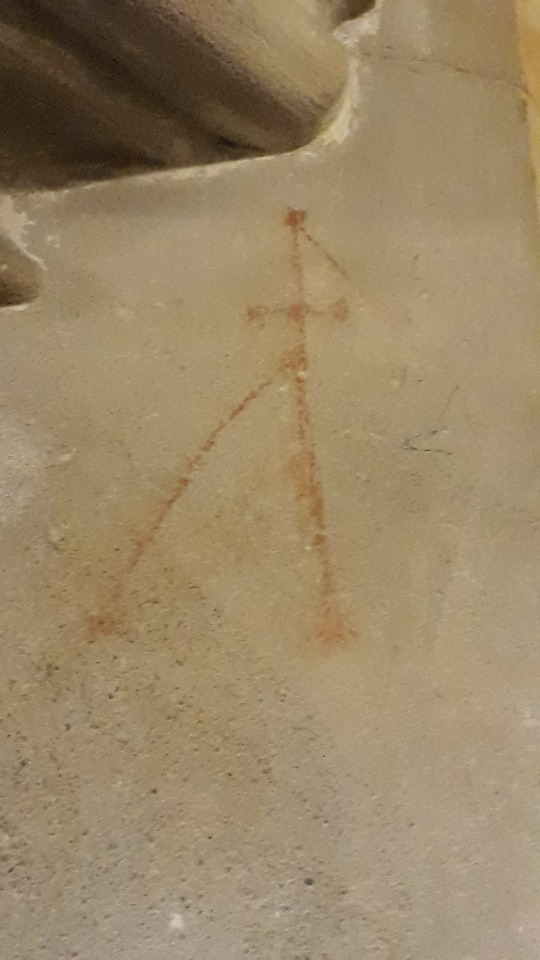
The drawing below is a much more complex symbol, although clearly triangular and with what most likely resembles beams penetrating from the centre. This could represent the Jesuit All Seeing Eye.

The interpretation of this symbol is supported by Gorlitz bordering Poland in a region predominantly traditionally protestant but returned to Catholicism by the society.
This adds support to the possibility of these symbols being gematria. The geometry of the shapes are most similar to Hebrew gematria, although still not fully interprated they appear to be numerical codes which either equate to a coded message or they identify locations of where reflections or sun beams fall on the walls at different dates and times or perhaps the combination of symbols connect to create a larger geometric pattern within the church.
On some walls there are indications of more complex lost images. Below could be interpreted as once the image of a knight.

Below is an image of a more complex painting, particularly on the left there is perhaps a painting including overlay of multiple characters who appear to be saints or disciples.

Some of the symbols combine to form other geometric and numerical patterns.

The gematria is often less angular and more in free flow, which likens it more to being an illuminati numerical code than purely Hebrew.

There are other examples of symbol combinations, again with geometric interpretations, even perhaps referencing star locations.

Others may represent the geometric or astrometric relationship with religion and the symbology of the cross.

Amongst the symbols there is also some more modern graffiti, unfortunately illegible but the style indicates that it may be from the 19th century.
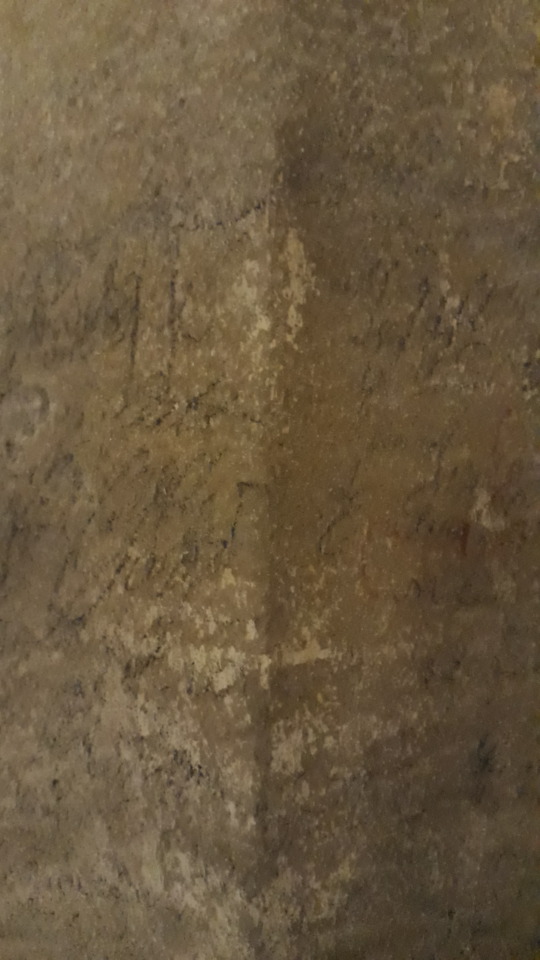
The true meaning of the gematria is certainly hidden in the plain sight of a more ancient representation or recording of a belief system kept secret from all but the initiated or determined, intrigued faith researcher.
1 note
·
View note
Text
One Race
I just learnt the best descriptive text of the #beauty of skin shades:
#condensedsunlight
I believe this summarise the beauty, depth, intrigue and inspiration of coloured skin.
We are #onerace but I believe in #blackorigin and the power of #melanin
0 notes
Text
A Spiritual Awakening in The Crypt of the Cathedral of Our Lady of Bayeux
When you walk through Bayeux, you are welcomed by the incredible sight of beauty that is the notre-dame, the Cathedral of Our Lady of Bayeux.

This wonderful structure of gothic art seems largely out of proportion with the size of the town and as you round the curved Eastern face it only grows in stature and beauty.

The understated beauty of the cathedral continues within, with ornately designed, rich colour stained glass windows.

Some alcoves are decorated with ancient paintings like those that surround a glistening metallic statue of St Micheal in the classic pose, magical, heroic, Kris sword held at full stretch over his head, poised to strike the dragon. Representative of the war between heaven and hell at the end of the earth.

The cathedral is home to a relic of Mary Catherine of St. Augustine containing one of her bones displayed in an elegant gold.

The remarkable beauty of this cathedral is hidden within a crypt below the choir which was a surprise to my visit. Well worn stone steps led down into a glorious crypt. It is particularly large for a crypt and ten symmetrically placed columns. Above the vault between the altar and a sacred rocky cave the ceiling is painted in blue with stars, representing a starry night sky, reminding me of the Da Vinci poem.

Intriguingly at the peak of the vault directly above the floor space of this vault is a symbol of the sun, representative of a singular, pre-christian God. In the centre is a triangle which could be representative of the Holy trinity or mind, body, spirit or past, present, future. Within the triangle is what appears to be Hebrew letters lamed, dalet, dalet, lamed.
This combination could be translated as a shepherds staff, door, door, shepherds staff, perhaps a reference to God as a shepherd opening or leading to a door and in return the door leads to God.

Six of the ten pillars are painted on the inner and altar facing sides. The red patches are adorned with gold coloured Angels. The red could represent the blood of Christ either in sacrifice or bloodline. The Angels are in a variety of poses including sounding horns to honour and rejoice or with their head bowed in prayer. Depictions of Angels in this manner are likely guarding or honouring those in the nave and for the altar.

The alcoves on one side of the crypt are painted with depictions of what appears to be saints, one of whom appears to be St Paul and both appear to be holding scrolls, perhaps scriptures.

In front of what appears to be an altar is an inscription in the stone floor ‘Hic Jacet’ which means ‘an epitaph’; ‘D D Duperrier’. This second part is likely a the name of or connected to Charles-François Duperrier-Dumourier, Bishop of Bayeux from 13th January 1823 until he died on 17th April 1827.

The alcove facing the empty focal point of the chamber is ornately decorated with vividly coloured and intriguing religious scene.
At the top of the alcove sits a representation of God holding and seemingly blessing the crucified Jesus Christ, the dove of peace, that carried his soul in ascension to heaven appears to be in actual contact with his slumped head.
A multitude of Angels surround the scheme, some in prayer and others holding banners of Latin text.

The positioning of this scene in the peak of the alcove makes it appear as the heavens over the painting on the wall below and note how the heavens connect and perhaps extend into the starry night above the focal point of the crypt.

When I first took this photo it was without flash, in darkness. As I took the image a bright ball of light on lens view seemed to briefly move up and out of the top of the shot in the instant before taking it. Nothing was captured in the photo but it intrigued me further as to what was special about this crypt and perhaps this painting in particular, so I activated the flash and took this image.
Two angels fly over a holy scene, where a saint is supporting / proffering a priest kneeling in prayer before what could be a blessing by Mary Magdalene with an unusually adult looking child on her lap. This could be a depiction of a child of Jesus.
The different halos are particularly interesting, with Mary wearing a crown with a cross at its front and the child seemingly more natural, perhaps in indication of the connection between Jesus and religion and faith and nature.
The identity of the saint is indicated by the dragon lying slain by the staff of the saints cross. This indicates that this is St George and perhaps he is so prominent in Bayeaux because he is featured in the Bayeux tapestry, which was housed in the cathedral from the Middle Ages to the beginning of the 19th Century. The true meaning of Saint George in Bayeaux remains a mystery.
The two pillars that front the vault facing into the empty focal point are painted with Saint Paul holding the key to Heaven. It is interesting how the image appears over painted with a red cross. The large read cross on the white robes is perhaps representative of the Knights Templar.

The other pillar also features another image of St Paul but holding a skull, symbolic of the power over death and a sword indicative of death and martyrdom. They stand on top of the pillars, perhaps representing the very pillars of the starry sky or of heaven.
The blue sky is crossed by a white band, which crosses in the centre, resembling The Saltire, which is representative of Scotland and St Andrew. Is this an indication of a connection between this crypt, its contents and the Templars settlement in Scotland. Perhaps a relic or relationship between whatever or whomever the crypt was created for and the Templars or another secret group or society in Scotland.

The saints both look down over where the focal point of the vault is now empty.

Adjacent alcoves also feature paintings such as the one below, again of St Paul, although this time carrying a sword to in memory of his martydom.

The empty space onto which the altar faces, the saints overlook and the decorative scene of Mary and a childlike Jesus must have once been been the resting place of a significantly important religious icon. It is particularly interesting to see that where, what look like the places were feet or corners rested, the stone slab floor appears to be scorched.

At the head of the crypt is a small gated recess, coins littering the inside in wishes and prayers of those who visit. It is an unusual space, which turns into a corner, perhaps it was built as a reliquary which once contained a religious artifact.

To the right of this unusual, cavern like recess is an unusual collection of features. One is clearly a location where holy communion goblets and plates would have been kept above a small sink which would have contained holy water for blessing the items before use.
There are other recesses and also markings of the walls indicating where plaques or pictures may also have been featured.

The longer I spent in the crypt the more I felt a presence. It was so intriguing and noticeable that when I left I felt the urge to return to explore the feeling further.
I returned down the entry steps into the crypt and then sat down on the second set of stones, which curved out like a fan down to the crypt floor. I tuned into my feelings of the surroundings and could feel a powerful force in the space.
I asked my travelling companions to return to experience the feeling for themselves and also to better understand if I was mistaken or really connecting to an unseen force. Two of the three returned at different times.
I did not share my feelings but asked them separately what they felt as we sat in the crypt.
One felt a tingling through their solar plexus and indicated this by instinctively making the sign of a cross over the area of their body.
Another and commented on having a headache whilst in the focal point of the crypt but not when out of it and had memories of their beloved deceased pet.
I could not spend too long in the crypt because I could feel a soft, dull head ache developing and felt a stronger and stronger tingling throughout my body and a shortness of breath.
That night I had a very clear dream, the first of such clarity as I create stories that I write.
The two companions who had entered the crypt with me were held in a bunker like chamber, with children, in an vast open, concrete basement. I was in the basement and I spoke with other people who were there, they were in conflict with others.
When I heard that children were held captive I went to the room. The door was opened and I entered; on a second glance at the group I saw my companions at the back of the group of children. I told them to leave through the door through which I had entered.
I left the room after them and thanked a man called David and I touched his thigh as I said thank you.
I had to tell my companions to run, the atmosphere was edgy. On the way out the younger companion stopped at a stone trough full of water and some snail like animals. They dipped their head into the water backwards, face up. I held their head and had to pinch a creature away from their nose before sending them on their way.
Although I could not interpret the dream and have yet to understand, it is intriguing that it included the two companions who entered the crypt and not the youngest companion. It is also interesting that the youngest companion had refused to enter the crypt because it had a strange feeling that made them afraid. It is also very intriguing that the two who were in the crypt also had a noticeable sensation.
There is certainly a presence of energy centered within the crypt, perhaps from a spirit or the resonance of a powerful item or individual who had been in that space for a period of time. It is purposeful in it’s design around the focal point, which currently remains empty, although it is interesting to wonder what was once there, what was it that was venerated with a large, highly decorated crypt, whose unusual decorations reflect a respectful, religious honor and guardian, rich with symbolism and mysticism.
It’s likely that this resting place was chosen because the energy already existed, perhaps as a ley line or geometric energy point.
2 notes
·
View notes
Text
There is certainly much more significance to this event than you may expect.
I hope no-one was injured, my thoughts are with those that are affected both physically and spiritually by this event.
I mourn the loss of the #ARTchitecture #ReligiousART and any secrets still waiting for discovery.
I wonder how this influences the date of celestial alignment with the churches and cathedrals across Europe predicted in the book 'Rosslyn, guardian of the secrets of the Holy Grail' by Tim Wallace-Murphy, we are only 3 months away and is this recurrence of 3 another key indicator as to the timing of this event?
If you wonder about the influences and truths in this event read more in this very interesting article from 2017.
0 notes
Text
Memories & Inspirations of Templarism: Lisieux

One of the finest representations of the crucifix that I’ve seen resides in the cathedral at Lisieux in France.
It towers high, shaped and detailed to replica real wood. The most interesting feature is the snake twined around the vertical. Throughout Christianity the symbol of a snake has represented temptation and evil but it’s pre-Christian symbolism has been hidden and is the most relevant in its representation of rebirth and new life, through how the snake sheds its skin. This powerful symbology correlates to the rebirth of Jesus, as he shed his Earthly, humanoid body and ascended into spiritual form.
When exploring spirituality and faith you must be prepared to research patterns and symbols of mystic that most would not consider. At Lisieux there is an intriguing mysticism to the storytelling of the life of Saint Theresa who founded the mission.

In the story below I was interested in the statement that they required a trinity of poses and that of all the possible witnesses it is that of the gardener who is referenced. This is significant in that when Jesus is reported as having appeared to Mary in the garden of his burial, Mary mistook him for the gardener. Was her comment intended for his ears because it was only a murmur but he heard the words and it could be understood as a a comment directed at him, encouraging him to take her spirit through death.

There is also the comment of Therese’s naming being sounding a though she is a child of Jesus, a theme of a number of the stories recounted throughout the church. It was on 10 January 1889 when Saint Therese was given the habit that she received the formal name of Thérèse of the Child Jesus.
It is this that intrigued me to look further and exploring this suggestion further finds some other interesting contributions such as Saint Therese being popularly known as "The Little Flower of Jesus" and she is regarded as one of the most popular saints in the history of the church.
Saint Therese is regarded as a highly influential model of sanctity for many catholics. Together with Saint Francis of Assisi, Saint Thérèse is one of the most popular Roman Catholic saints since apostolic times. Pope Saint Pius X called her "the greatest saint of modern times".
Saint Therese’s parents remain the first and only married couple to be canonized.
Louis Martin, Thérèse’s father gave pet names to his children and Therese was his petite reine, little queen, to whom all treasures belonged.
It was Christmas Eve of 1886 that Thérèse her "complete conversion." Years later she stated that on that night she overcame the pressures she had faced since the death of her mother and said that "God worked a little miracle to make me grow up in an instant ... On that blessed night … Jesus, who saw fit to make Himself a child out of love for me, saw fit to have me come forth from the swaddling clothes and imperfections of childhood"
After her death Therese’s body was exhumed in September 1910 and the remains placed in a lead coffin and transferred to another tomb.
Saint Therese was recognised as a Doctor of the Church, a title given by the Catholic Church to saints whom they recognize as having made significant contribution to theology or doctrine through their research study, or writing. This title is an English interpretation of the original Latin title in which Doctor means Teacher, a title be which Jesus was commonly known.
Other Doctor’s of the Church include Saint Bernard of Clairvaux (1090 – 20 August 1153), a French abbot and a major leader in the reform of Benedictine monasticism that caused the formation of the Cistercian order. In the year 1128, Bernard attended the Council of Troyes and created the Rule of the Knights Templar, which soon became the ideal of Christian nobility.
In 1895 Saint Theresa composed the poem "My Heaven down here", was this in reference to Theresa having knowledge of heaven and how it could be transposed on Earth? In the poem Therese expresses the notion that by the divine union of love, the soul takes on the semblance of Christ. By contemplating the sufferings associated with the Holy Face of Jesus, she felt she could become closer to Christ. She wrote the words "Make me resemble you, Jesus!" on a small card and attached a stamp with an image of the Holy Face. She pinned the prayer in a small container over her heart.
On her death-bed Saint Therese said, "I only love simplicity. I have a horror of pretence", was this perhaps a reference to her own pretence of her own relationship with Jesus?
Pope Benedict XV dispensed with the usual fifty-year delay required between death and beatification and on 14th August 1921, he promulgated the decree on the heroic virtues of Thérèse declaring her "Venerable". She was beatified on 29th April 1923. Therese was canonized on 17th May 1925 by Pope Pius XI, only 28 years after her death.
It is interesting that Thérèse was declared a saint five years and a day after Joan of Arc. As yet the reason for the exactness for this timing is not clear.
However, the 1925 celebration for Thérèse "far outshone" that for the legendary heroine of France. Pope Pius XI revived the old custom of covering St. Peter's with torches and tallow lamps. According to one account, "Ropes, lamps and tallows were pulled from the dusty storerooms where they had been packed away for 55 years. A few old workmen who remembered how it was done the last time, in 1870, directed 300 men for two weeks as they climbed about fastening lamps to St. Peter's dome." The New York Times ran a front-page story about the occasion titled, "All Rome Admires St. Peter's Aglow for a New Saint".

According to the Times, over 60,000 people, estimated to be the largest crowd inside St. Peter's Basilica since the coronation of Pope Saint Pius X, 22 years before, witnessed the canonization ceremonies. In the evening, 500,000 pilgrims pressed into the lit square.
She rapidly became one of the most popular saints of the twentieth century. Her feast day was added to the General Roman Calendar in for celebration on October 3rd. In 1969, 42 years later, Pope Paul VI moved it to October 1st, the day after her dies natalis (birthday to heaven).
In 1944 Pope Pius XII decreed her a co-patron of France with Saint Joan of Arc. The principal patron of France is the Blessed Virgin Mary.
By the Apostolic Letter Divini Amoris Scientia (The Science of Divine Love) of 19th October 1997, Pope Saint John Paul II declared her the thirty-third Doctor of the Church, the youngest person, and one of only four women so named, the others being Teresa of Ávila (Saint Teresa of Jesus), Hildegard of Bingen and Catherine of Siena.
This small group of women becomes of great interest to focus the research on Saint Theresa’s peer group to further explore the understanding of the importance and relevance of her being made a Doctor of the Church and associated with them.
Teresa of Avila is a particularly interesting individual with whom to start. Teresa is also known as Saint Teresa of Jesus who lived 28th March 1515 – 4th October 1582 was known as a prominent Spainish mystic; mysticism being in strong association with pre-Christian faiths.
Her paternal grandfather, Juan Sánchez de Toledo, was a marrano (a Jewish man who was forcibly converted to Christianity). When Teresa's father was a child, Juan was condemned by the Spanish Inquisition for allegedly returning to the Jewish faith, but he was able to convince them otherwise and re-assume a Christian identity. A Jewish family legacy brings Teresa’s lineage closer to a possible connection with the blood line of Jesus.
When her mother died, Teresa found comfort in a deep devotion to the Virgin Mary as her spiritual mother, perhaps a natural calling.
Teresa’s connection to an older religious faith manifested in her widening learning of spiritualism. As the Catholic distinction between mortal and venial sin became clear to her, she says she came to understand the awful terror of sin and the inherent nature of original sin. She also became conscious of her own natural impotence in confronting sin and the necessity of absolute subjection to God.
Around 1556, various friends suggested that her newfound knowledge was diabolical, not divine. This knowledge could have been an indicator of Teresa’s learning of a secret or hidden knowledge shared through her lineage, through the relationship of her blood line.
She began to inflict various tortures and mortifications of the flesh upon herself. But her confessor, the Jesuit Saint Francis Borgia, reassured her of the divine inspiration of her thoughts. On St. Peter's Day in 1559, Teresa became firmly convinced that Jesus Christ presented himself to her in bodily form, though invisible. These visions lasted almost uninterrupted for more than two years. In another vision, a seraph drove the fiery point of a golden lance repeatedly through her heart, causing an ineffable spiritual and bodily pain:
“I saw in his hand a long spear of gold, and at the point there seemed to be a little fire. He appeared to me to be thrusting it at times into my heart, and to pierce my very entrails; when he drew it out, he seemed to draw them out also, and to leave me all on fire with a great love of God. The pain was so great, that it made me moan; and yet so surpassing was the sweetness of this excessive pain, that I could not wish to be rid of it...”
This vision was the inspiration for one of Bernini's most famous works, the Ecstasy of Saint Teresa at Santa Maria della Vittoria in Rome.

By Alvesgaspar - Own work, CC BY-SA 4.0, https://commons.wikimedia.org/w/index.php?curid=43527951
This iconic work of art which was used as an inspiration for Robert Langdon investigation of the path to Illumination in Angels and Demons. As in the movie is this a hidden message that directs your attention to the truth of a connection of the illuminati to Teresa and her pre-Christian heritage, which carries the power of knowledge that could threaten to bring down the mysticism and power of the church.
Another of the earlier female Doctors of the Church was Hildegard of Bingen 1098 – 17 September 1179 a German Benedictine abbess, writer, composer, philosopher, Christian mystic, visionary, and polymath.
Saint Hildegard wrote Liber Divinorum Operum "Universal Man" about 400 years before the image and interpretation of the mystery of man was immortalised in Leonardo Da Vinci’s Vitruvian Man.
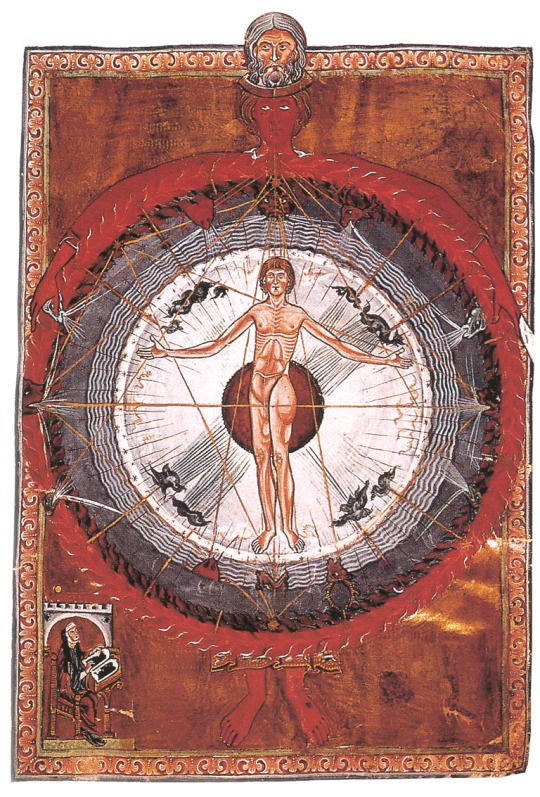
This was Saint Hildegard's last and grandest visionary work had its genesis in one of the few times she experienced something like an ecstatic loss of consciousness. As she described it in an autobiographical passage included in her Vita, sometime in about 1163, she received "an extraordinary mystical vision" in which was revealed the "sprinkling drops of sweet rain" that John the Evangelist experienced when he wrote, "In the beginning was the Word..." (John 1:1). Hildegard perceived that this Word was the key to the "Work of God", of which humankind is the pinnacle.
The Book of Divine Works, therefore, became in many ways an extended explication of the Prologue to John's Gospel.The ten visions of this work's three parts are cosmic in scale, to illustrate various ways of understanding the relationship between God and his creation. Often, that relationship is established by grand allegorical female figures representing Divine Love (Caritas) or Wisdom (Sapientia). The true, overwhelming influence and power of femininity is divine in many aspects.
The first vision opens the work with a salvo of poetic and visionary images, swirling about to characterize God's dynamic activity within the scope of his work within the history of salvation.
The remaining three visions of the first part introduce the famous image of a human being standing astride the spheres that make up the universe, and detail the intricate relationships between the human as microcosm and the universe as macrocosm. This culminates in the final chapter of Part One, Vision Four with Hildegard's commentary on the Prologue to John's Gospel (John 1:1-14), a direct rumination on the meaning of "In the beginning was the Word..." The single vision that comprises the whole of Part Two stretches that rumination back to the opening of Genesis, and forms an extended commentary on the seven days of the creation of the world told in Genesis 1-2:3. This commentary interprets each day of creation in three ways: literal or cosmological; allegorical or ecclesiological (i.e. related to the Church's history); and moral or tropological (i.e. related to the soul's growth in virtue).
Finally, the five visions of the third part take up again the building imagery of Scivias to describe the course of salvation history. The final vision (3.5) contains Hildegard's longest and most detailed prophetic program of the life of the Church from her own days of "womanish weakness" through to the coming and ultimate downfall of the Antichrist.
This incredible work of vision and divine inspiration could be some of the greatest wisdom ever bestowed upon humanity. Imagine for a moment if just one of these visions were real and a true message from God through Hildegard. This and her other works of vision interpretation reveal the meaning behind creation, our relationship to divinity and the universe pre-Bible scripture.
Saint Hildegard’s inspired knowledge and wisdom are clearly expressed through her medicinal and scientific writings, though thematically complementary to her ideas about nature expressed in her visionary works, they are different in focus and scope. Neither claim to be rooted in her visionary experience and its divine authority. Rather, they spring from her experience helping in and then leading the monastery's herbal garden and infirmary, as well as the theoretical information she likely gained through her wide-ranging reading in the monastery's library, a library no doubt of great wealth in ancient, pre-Christian knowledge. As she gained practical skills in diagnosis, prognosis, and treatment, she combined physical treatment of physical diseases with holistic methods centered on "spiritual healing." She became well known for her healing powers involving practical application of tinctures, herbs, and precious stones. She combined these elements with a theological notion ultimately derived from Genesis: all things put on earth are for the use of humans. In addition to her hands-on experience, she also gained medical knowledge, including elements of her humoral theory, from traditional Latin texts.
Hildegard cataloged both her theory and practice in two works. The first, Physica, containg nine books that describe the scientific and medicinal properties of various plants, stones, fish, reptiles, and animals. The second, Causae et Curae, is an exploration of the human body, its connections to the rest of the natural world, and the causes and cures of various diseases.
In the first part of Causae et Curae there is the context of the creation of the cosmos and then humanity as its summit, and the constant interplay of the human person as microcosm both physically and spiritually with the macrocosm of the universe informs all of Hildegard's approach. Her hallmark is to emphasize the vital connection between the "green" health of the natural world and the holistic health of the human person. Viriditas, or greening power, was thought to sustain human beings and could be manipulated by adjusting the balance of elements within a person. Thus, when she approached medicine as a type of gardening, it was not just as an analogy. Rather, Hildegard understood the plants and elements of the garden as direct counterparts to the humors and elements within the human body, whose imbalance led to illness and disease.
Thus, the nearly three hundred chapters of the second book of Causae et Curae "explore the etiology, or causes, of disease as well as human sexuality, psychology, and physiology." In this section, she give specific instructions for bleeding based on various factors, including gender, the phase of the moon (bleeding is best done when moon is waning), the place of disease (use veins near diseased organ of body part) or prevention (big veins in arms), and how much blood to take (described in imprecise measurements, like "the amount that a thirsty person can swallow in one gulp").
In the third and fourth sections, Hildegard describes treatments for malignant and minor problems and diseases according to the humoral theory, again including information on animal health.
The fifth section is about diagnosis and prognosis, which includes instructions to check the patient's blood, pulse, urine and stool. Finally, the sixth section documents a lunar horoscope to provide an additional means of prognosis for both disease and other medical conditions, such as conception and the outcome of pregnancy. For example, she indicates that a waxing moon is good for human conception and is also good for sowing seeds for plants (sowing seeds is the plant equivalent of conception). Elsewhere, Hildegard is even said to have stressed the value of boiling drinking water in an attempt to prevent infection.
As Hildegard elaborates the medical and scientific relationship between the human microcosm and the macrocosm of the universe, she often focuses on interrelated patterns of four: "the four elements (fire, air, water, and earth), the four seasons, the four humors, the four zones of the earth, and the four major winds."
Although she inherited the basic framework of humoral theory from ancient medicine, Hildegard's conception of the hierarchical inter-balance of the four humors (blood, phlegm, black bile, and yellow bile) was unique, based on their correspondence to "superior" and "inferior" elements, blood and phlegm corresponding to the "celestial" elements of fire and air, and the two biles corresponding to the "terrestrial" elements of water and earth. Hildegard understood the disease-causing imbalance of these humors to result from the improper dominance of the subordinate humors. This disharmony reflects that introduced by Adam and Eve in the Fall, which for Hildegard marked the indelible entrance of disease and humoral imbalance into humankind. As she writes in Causae et Curae c. 42:
“It happens that certain men suffer diverse illnesses. This comes from the phlegm which is superabundant within them. For if man had remained in paradise, he would not have had the flegmata within his body, from which many evils proceed, but his flesh would have been whole and without dark humor [livor]. However, because he consented to evil and relinquished good, he was made into a likeness of the earth, which produces good and useful herbs, as well as bad and useless ones, and which has in itself both good and evil moistures. From tasting evil, the blood of the sons of Adam was turned into the poison of semen, out of which the sons of man are begotten. And therefore their flesh is ulcerated and permeable [to disease]. These sores and openings create a certain storm and smoky moisture in men, from which the flegmata arise and coagulate, which then introduce diverse infirmities to the human body. All this arose from the first evil, which man began at the start, because if Adam had remained in paradise, he would have had the sweetest health, and the best dwelling-place, just as the strongest balsam emits the best odor; but on the contrary, man now has within himself poison and phlegm and diverse illnesses.”
Saint Hildegard is the first recorded female Doctor of the Church, a record of spiritually inspired, women who are revered, even officially by the church, for their expansion and exploration of spiritualism, even though this challenged doctrine and sanctioned Christian belief or was this acceptance how the church continued its millenia of the assimilation of the truth of the bloodline of Jesus and the truth of the nature of the divine symbiotic relationship and harmony between all life.
3 notes
·
View notes
Text
Memories & Inspirations of Templarism: Rouen
During a holiday to Rouen in France I noted the reference to an old temple place on the city centre map in our rented apartment. Knowing that names historically bearing the word temple are all referencing an ancient link to Templarism, I made visiting the location a priority of my stay.
I expected to find some evidence of perhaps a what could have been an ancient Templar castle or keep, likely long ruined or unrecognisable, particularly because of the French King’s determination to eradicate the legacy of the Templars.
I was surprised and very impressed to find a fully intact temple, Temple Saint Eloi.
A church was built on a island in the Seine from approximately July 5th 1228
The 5th of July is the birthday date of Mayan ruler Ahkal Mo' Naab' I in the year 465 and perhaps an early indication of an ancient heritage to the location. It is also a date associated with the celebration of St Modwenna, who founded Burton Abbey in Staffordshire in England in the 7th century.
St Modwenna’s legacy is intriuging and mystical, shrouded in myth perfect for an older association with the beliefs and knowledge that inspired Templarism and Gnosticism. St Modwenna is believed to have lived to 130 years old and raised Saint Oswyth, daughter of Wilburga, daughter of the pagan King Penda of Mercia. A medieval Anglo-Norman text tells of how Alfred the Great personally knew St Modwenna, although he reigned some 200 years later, supporting the belief of her extended life or perhaps that she shared knowledge that lead to a transference of her spirit.
St Oswyth’s mother, Wilburg was the daughter of King Penda, a son of Pybba of Mercia and said to be an Icling, with a lineage purportedly extending back to pre-Christian, pre-Roman, Norse mythological God Wōden. Perhaps this lineage, associations and miracles support further the understanding and sharing of great knowledge and power which has been overshadowed by doctrine, Christianity and the regal establishments crusade for unchallenged power.
The miracle that most caught my attention was perhaps the application of this ancient family power, tutored under the direction of St Modwenna in that after her execution St Oswyth stood up, picking up her head like Saint Denis in Paris, and other cephalophoric martyrs and walked with it in her hands, to the door of a local convent, before collapsing there. The legends of cephalophores miraculously walking with their heads in their hands may be related to the Celtic cult of heads.
The discovery of the temple is started with a view of the a great West window with a clearly marked great heptagram, with a heptagram at its centre.
The central heptagram resembles a star at the centre of a sun, perhaps a child within a God.
Within the heptagram is a flower, representative of femininity and lining the perimeter are hearts to indicate love and the sacred heart.

The dedication of the temple to Saint Eloi is perhaps most poignant as he is predominantly recognised as the patron saint of goldsmiths and this could indicate that this temple, close to the banks of the Seine in an important river shipping city, was perfectly placed for moving Templar wealth in and out of Paris. This may even have been a location for the evacuation of Templar gold and treasure just prior to the issue of the arrest warrant.

On the North side of the temple is another beautiful window featuring hearts and flames appearing to grow from the structure of the window frame and in the wood paneled door below a subtle hexagram, the star of creation in Christianity. The Seal of Soloman is representative of the path to higher spirituality.

Further indication of the influence and inspiration of Templarism is the decorative stone features, including the long reaching gargoyles and the flying buttresses, somewhat reminiscent of other inspired works of stonemasonry of the same period and influence, namely Rosslyn Chapel in Scotland.
The work is signed on the West facing wall by ‘Barbe’, a family of glass painters whose legacy became legendary in Rouen, it is likely that these windows were completed later in the Temple’s life most likely when it was rebuilt in the 16th century.
Further evidence of the influence of the Templars on Rouen can be found on Rue du Gros Horloge. Les Gros Horloge is one of the oldest in France and although it was constructed in 1389, there are a significant number of Templar inspired features.
It is so much more than a timepiece, it also indicates the phase of the moon by the representation at its top and the days of the week in the dial at its base.

More significantly below this in the peak of the arch is an interesting combination of symbols.
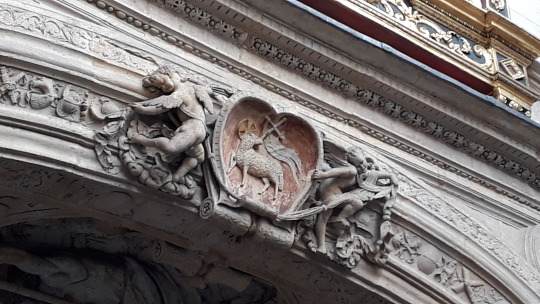
The red heart is representative of the heart of Jesus or the love of Jesus and there is a direct relationship between this and the secret knowledge or powers that inspired Templarism.
The sheep represents spiritual living, community or followers and being inside the heart this would represent the followers or community of Jesus. It also represents Jesus as the lamb of God, the self sacrifice of faith.
The sheep has a halo of the Templar cross and carries a cross with a banner hung from it, representing the religious crusade of the Templars and their protection of Christianity through battle and occupation of Holy sites, which ultimately contributed to their understanding or a great and secret knowledge.
The baby cherubs as humans are representative of humanity and the original meaning of a cherub was for the protection of the Garden of Eden a symbol of the garden of human and religious origin and the interconnective balance of humans and nature.
This depiction is beautifully sculptured in the stone beneath the clocktowers arch. A haloed shepherd, almost desperately hanging onto their staff with one hand is reaching down to feed a sheep grain from the open palm of their other.
The detail is superb, the shepherd features a whistle hanging around their neck.
The shepherd and their flock are in front of a detailed woodland, including even the detail of their secondary branches. They are at one within their natural surroundings.
The quality of the workmanship is reminiscent of the masterpieces of stonemasonary associated with the inspirations of Templarism and gnostic beliefs such as Rosslyn Chapel in Scotland.
The inscription reads ‘animam suam dat pro ovibus suis’ which translates as ‘gives his life for his sheep’.This comes from the Gospel of John, and reads: Ego sum pastor bonus. Bonus pastor animam suam dat pro ovibus suis, "I am the good shepherd. The good shepherd gives up his life for his sheep." It is interesting that the piece ‘Bonus pastor’, ‘Good Shepherd’ is missing, perhaps deliberately as a message of perhaps this is a lost piece of the sculpture.
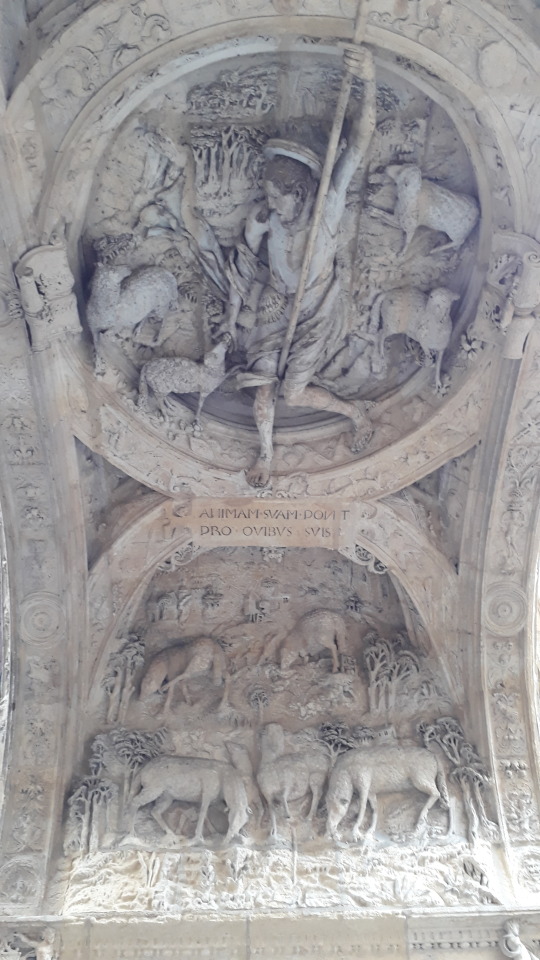
In the lower portion of the frieze there is further incredible detail in the township, complete with chateaux, a mill and a cottage in the woods. The trees of the landscape feature, natural flows of branches and foliage. The human working township, sheep, trees and undergrowth, all depicting the joint balance of life.
Master craftsmanship of stone masonary and art continue to surprise you as you are drawn to look closer and find new images within the undergrowth. Below you can see a close up of what could be a leaping hare or rabbit beside what appears to be the painted head of a rabbit, with even the downturned mouth. Does this indicate that this frieze was once decoratively painted, alive with colour?
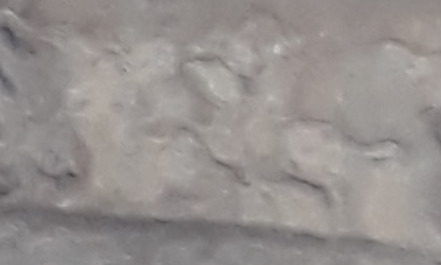
Elsewhere there is what appears to a a distant perspective of a person either following a horse as it rears up on its hind legs or is the figure reaching upwards to stave off a rampant dragon?
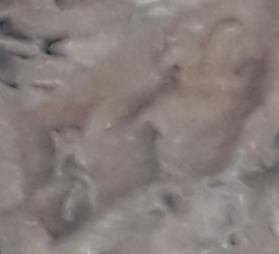
It is interesting that the sheep at the base of the sculpture look very different to the others, their legs, long necks and snouts, even the way one scratches its ear with its hind leg, they almost resemble more like wolfs than sheep. Is there a deeper message here of the wolves that hunt the sheep or of the balance and co-existence that resides in nature?
3 notes
·
View notes
Text
A Walk from Clerkenwell to London Bridge
I took the opportunity to visit the new White Collar Factory in London because it was being widely reported as the trendiest new workplace in the city.
I started at Orangebox: http://www.orangebox.com/
Selecting a new vinyl covering for a sofa and admiring the latest furniture finishes, including table tops which would not show touch marks.
I walked from Clerkenwell to Old Street.

I was interested by Great Sutton Street and detoured to find an impressive collection of furniture and workplace design studios.
A great place to visit if your planning a new hotel or workplace.
On Old Street I was intrigued by Look Mum No Hands!
youtube
A bicycle repair shop serving coffee, pastry and beer in an urban setting.
Further down the street I found a Strawberry Bench, at excellent addition to a modern street setting, although I hoped that the council would have kept it cleaner.
vimeo
At Old Street's Silicone Roundabout I reached the my destination, White Collar Factory.
vimeo
I love good and attractive use of concrete and at White Collar Factory I loved the wood grain effect concrete.

I enjoyed the wood button push pads in the revolving doors.
I found the scissor lift styled tables in the lobby industrial and interesting.

The large industrial lights provided character and the bright yellow ceiling track was a quirky feature which hints towards the versatility of how the space can be used.
I usually enjoy exposed air conditioning, wiring and sprinklers, this was no exception.
The floor had a rustic sawn wood panel effect and cute eyelet handles.
I was surprised by the £3.30 for a small latte but impressed by the flavour of the boutique London roasted coffee from Workshop: https://workshopcoffee.com/

It was unfortunate that the service at the reception could have been warmer and friendlier. I observed the receptionist interact with a guest and it was decidedly cold and unwelcoming. It was not helped by the receptionist being seated at one of the scissor lift tables which is far too wide for a seated service.
Leaving the factory I headed for London Bridge.

The route took me past an beautiful new building with undulating waves of frontage.
http://www.10finsburysquare.com/

Beyond this I was impressed by the recently cleaned Victorian London 13-15 Moorgate (former Metropolitan Life Assurance building). Architect William Silver Frith built this beautiful stone property between 1890-93.

The statues read from left to right: Confidence, Prudence, Justice, Truth, Thrift and Self-Denial. On King’s Arms Yard, they read: Self-Denial and Thrift. At the north end of the building, they read: Truth and Justice. Located on the west side of Moorgate Street, at the junction with King's Arms Yard.
#clerkenwell#londonbridge#old street#look mum no hands#strawberry bench#white collar factory#finsbury square#london
0 notes
Text
Memories & Inspirations of Templarism : Salzburg
At the foot of the Festunsberg in Salzburg, Austria, is the the oldest graveyard in the UNESCO World Heritage city, Petersfriedhof, St Peter’s Cemetery.
https://en.wikipedia.org/wiki/Petersfriedhof_Salzburg
The beautiful graveyard bears many unusual and highly decorated graves. This monument is to Sebastien Stumpfegger a master mason responsible throughout Germany for many notable works.
https://translate.google.com/translate?hl=en&sl=de&u=https://de.wikipedia.org/wiki/Sebastian_Stumpfegger&prev=search
The classic mason compass and angle symbols top the monument. The masons are associated as a descendant from the Templars. The central pyramid is symbolic of ancient Egyptian understanding of creation, pre-Christian religious beliefs and life’s association with the power of the stars.
There is also the central clear line in the centre of the text within the pryamid which forms the stem of a cross and ends in contact with a skull. This is symbolic of a greater knowledge through the enlightenment of religion.

In Max-Reinhardt Platz in the heart of old Salzburg is the Wilder Mann Brunnen statue, the greatest Green Man statue I’ve seen to date. The Green Man is one of the frequently and often subtely used symbolic references to pre-Christian religion with beliefs founded in nature and the power in the life of the Earth.

In the old town of Salzburg above the arch of an unasuming house are the words ‘God is protecting this house and all who walk in and out’, above which the all seeing eye watches.

The symbol is more historically founded as the eye of the pre-Christian God, Anu.

The eye of Anu also appears on a number of grave memorials. This cross is decorate with miniature pyramids, in the center of which you find the eye.

After the Christmas service was the most poignant modern connection to the memories of the past.

Collecting at the door in full regalia, members of the Hospitallers, a similar almost rival group to the Templars with with many similarities, particularly in that following the dissolution of the order many of it’s lands, properties and possessions were awarded into the customdy of the Hospitallers who were founded on charitable care for those in need.

The all seeing eye of God appears in the most subtle locations, like in the eaves of this house, with the words ‘In God’s sight is everything’.

There are even more subtle references hidden in the ornate ceiling of St Nicholas church.

0 notes
